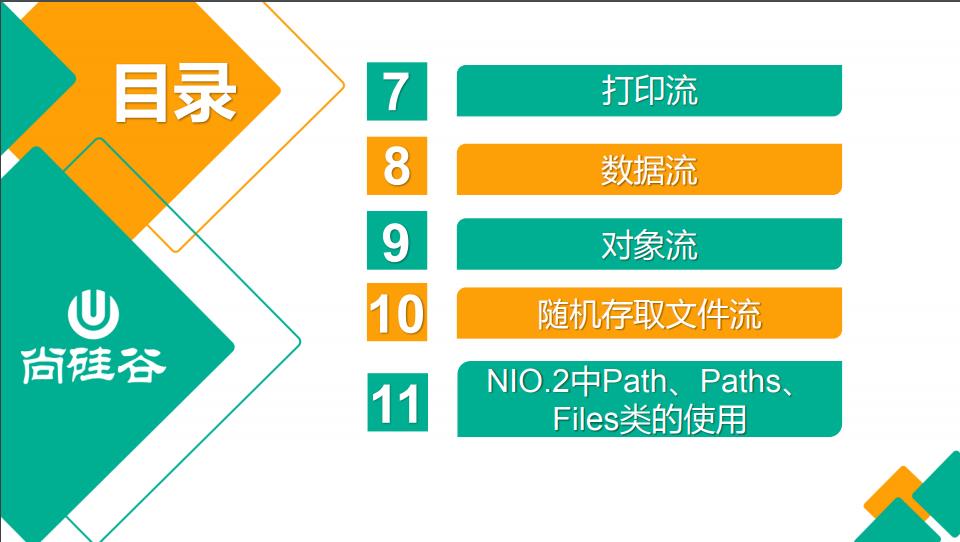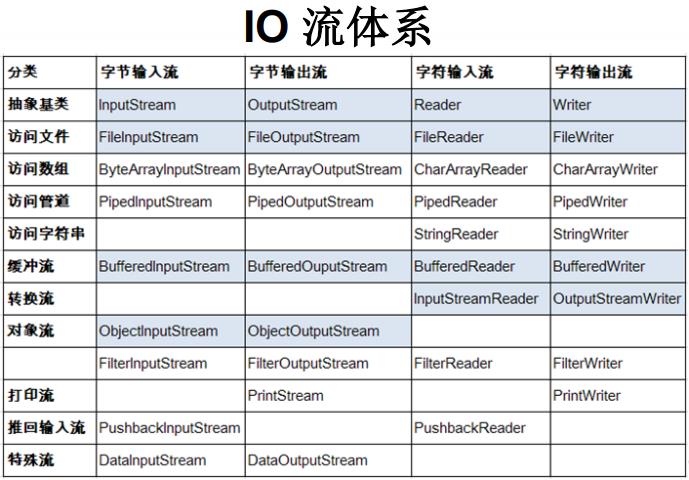Java基础13(IO流)
Posted 旋转的格子
tags:
篇首语:本文由小常识网(cha138.com)小编为大家整理,主要介绍了Java基础13(IO流)相关的知识,希望对你有一定的参考价值。





package com.atguigu.java3; import org.junit.Test; import java.io.File; import java.io.IOException; import java.util.Date; /** * File类的使用 * * 1. File类的一个对象,代表一个文件或一个文件目录(俗称:文件夹) * 2. File类声明在java.io包下 * 3. File类中涉及到关于文件或文件目录的创建、删除、重命名、修改时间、文件大小等方法, * 并未涉及到写入或读取文件内容的操作。如果需要读取或写入文件内容,必须使用IO流来完成。 * 4. 后续File类的对象常会作为参数传递到流的构造器中,指明读取或写入的"终点". * * * * * @author shkstart * @create 2019 下午 4:05 */ public class FileTest { /* 1.如何创建File类的实例 File(String filePath) File(String parentPath,String childPath) File(File parentFile,String childPath) 2. 相对路径:相较于某个路径下,指明的路径。 绝对路径:包含盘符在内的文件或文件目录的路径 3.路径分隔符 windows:\\\\ unix:/ */ @Test public void test1(){ //构造器1 File file1 = new File("hello.txt");//相对于当前module File file2 = new File("D:\\\\workspace_idea1\\\\JavaSenior\\\\day08\\\\he.txt"); System.out.println(file1); System.out.println(file2); //构造器2: File file3 = new File("D:\\\\workspace_idea1","JavaSenior"); System.out.println(file3); //构造器3: File file4 = new File(file3,"hi.txt"); System.out.println(file4); } /* public String getAbsolutePath():获取绝对路径 public String getPath() :获取路径 public String getName() :获取名称 public String getParent():获取上层文件目录路径。若无,返回null public long length() :获取文件长度(即:字节数)。不能获取目录的长度。 public long lastModified() :获取最后一次的修改时间,毫秒值 如下的两个方法适用于文件目录: public String[] list() :获取指定目录下的所有文件或者文件目录的名称数组 public File[] listFiles() :获取指定目录下的所有文件或者文件目录的File数组 */ @Test public void test2(){ File file1 = new File("hello.txt"); File file2 = new File("d:\\\\io\\\\hi.txt"); System.out.println(file1.getAbsolutePath()); System.out.println(file1.getPath()); System.out.println(file1.getName()); System.out.println(file1.getParent()); System.out.println(file1.length()); System.out.println(new Date(file1.lastModified())); System.out.println(); System.out.println(file2.getAbsolutePath()); System.out.println(file2.getPath()); System.out.println(file2.getName()); System.out.println(file2.getParent()); System.out.println(file2.length()); System.out.println(file2.lastModified()); } @Test public void test3(){ File file = new File("D:\\\\workspace_idea1\\\\JavaSenior"); String[] list = file.list(); for(String s : list){ System.out.println(s); } System.out.println(); File[] files = file.listFiles(); for(File f : files){ System.out.println(f); } } /* public boolean renameTo(File dest):把文件重命名为指定的文件路径 比如:file1.renameTo(file2)为例: 要想保证返回true,需要file1在硬盘中是存在的,且file2不能在硬盘中存在。 */ @Test public void test4(){ File file1 = new File("hello.txt"); File file2 = new File("D:\\\\io\\\\hi.txt"); boolean renameTo = file2.renameTo(file1); System.out.println(renameTo); } /* public boolean isDirectory():判断是否是文件目录 public boolean isFile() :判断是否是文件 public boolean exists() :判断是否存在 public boolean canRead() :判断是否可读 public boolean canWrite() :判断是否可写 public boolean isHidden() :判断是否隐藏 */ @Test public void test5(){ File file1 = new File("hello.txt"); file1 = new File("hello1.txt"); System.out.println(file1.isDirectory()); System.out.println(file1.isFile()); System.out.println(file1.exists()); System.out.println(file1.canRead()); System.out.println(file1.canWrite()); System.out.println(file1.isHidden()); System.out.println(); File file2 = new File("d:\\\\io"); file2 = new File("d:\\\\io1"); System.out.println(file2.isDirectory()); System.out.println(file2.isFile()); System.out.println(file2.exists()); System.out.println(file2.canRead()); System.out.println(file2.canWrite()); System.out.println(file2.isHidden()); } /* 创建硬盘中对应的文件或文件目录 public boolean createNewFile() :创建文件。若文件存在,则不创建,返回false public boolean mkdir() :创建文件目录。如果此文件目录存在,就不创建了。如果此文件目录的上层目录不存在,也不创建。 public boolean mkdirs() :创建文件目录。如果此文件目录存在,就不创建了。如果上层文件目录不存在,一并创建 删除磁盘中的文件或文件目录 public boolean delete():删除文件或者文件夹 删除注意事项:Java中的删除不走回收站。 */ @Test public void test6() throws IOException { File file1 = new File("hi.txt"); if(!file1.exists()){ //文件的创建 file1.createNewFile(); System.out.println("创建成功"); }else{//文件存在 file1.delete(); System.out.println("删除成功"); } } @Test public void test7(){ //文件目录的创建 File file1 = new File("d:\\\\io\\\\io1\\\\io3"); boolean mkdir = file1.mkdir(); if(mkdir){ System.out.println("创建成功1"); } File file2 = new File("d:\\\\io\\\\io1\\\\io4"); boolean mkdir1 = file2.mkdirs(); if(mkdir1){ System.out.println("创建成功2"); } //要想删除成功,io4文件目录下不能有子目录或文件 File file3 = new File("D:\\\\io\\\\io1\\\\io4"); file3 = new File("D:\\\\io\\\\io1"); System.out.println(file3.delete()); } }
-----------------练习---------------------


package com.atguigu.exer2; import org.junit.Test; import java.io.File; import java.io.IOException; /** * @author shkstart * @create 2019 下午 4:56 */ public class FileDemo { @Test public void test1() throws IOException { File file = new File("D:\\\\io\\\\io1\\\\hello.txt"); //创建一个与file同目录下的另外一个文件,文件名为:haha.txt File destFile = new File(file.getParent(),"haha.txt"); boolean newFile = destFile.createNewFile(); if(newFile){ System.out.println("创建成功!"); } } }

package com.atguigu.exer2; import org.junit.Test; import java.io.File; import java.io.FilenameFilter; /** * 课后练习2:判断指定目录下是否有后缀名为.jpg的文件,如果有,就输出该文件名称 * @author shkstart 邮箱:shkstart@126.com * @version 创建时间:2019年2月23日 上午1:55:59 * */ public class FindJPGFileTest { @Test public void test1(){ File srcFile = new File("d:\\\\code"); String[] fileNames = srcFile.list(); for(String fileName : fileNames){ if(fileName.endsWith(".jpg")){ System.out.println(fileName); } } } @Test public void test2(){ File srcFile = new File("d:\\\\code"); File[] listFiles = srcFile.listFiles(); for(File file : listFiles){ if(file.getName().endsWith(".jpg")){ System.out.println(file.getAbsolutePath()); } } } /* * File类提供了两个文件过滤器方法 * public String[] list(FilenameFilter filter) * public File[] listFiles(FileFilter filter) */ @Test public void test3(){ File srcFile = new File("d:\\\\code"); File[] subFiles = srcFile.listFiles(new FilenameFilter() { @Override public boolean accept(File dir, String name) { return name.endsWith(".jpg"); } }); for(File file : subFiles){ System.out.println(file.getAbsolutePath()); } } }

package com.atguigu.exer2; import java.io.File; /** * 3. 遍历指定目录所有文件名称,包括子文件目录中的文件。 拓展1:并计算指定目录占用空间的大小 拓展2:删除指定文件目录及其下的所有文件 * @author shkstart 邮箱:shkstart@126.com * @version 创建时间:2019年2月23日 上午1:55:31 * */ public class ListFilesTest { public static void main(String[] args) { // 递归:文件目录 /** 打印出指定目录所有文件名称,包括子文件目录中的文件 */ // 1.创建目录对象 File dir = new File("E:\\\\teach\\\\01_javaSE\\\\_尚硅谷Java编程语言\\\\3_软件"); // 2.打印目录的子文件 printSubFile(dir); } public static void printSubFile(File dir) { // 打印目录的子文件 File[] subfiles = dir.listFiles(); for (File f : subfiles) { if (f.isDirectory()) {// 文件目录 printSubFile(f); } else {// 文件 System.out.println(f.getAbsolutePath()); } } } // 方式二:循环实现 // 列出file目录的下级内容,仅列出一级的话 // 使用File类的String[] list()比较简单 public void listSubFiles(File file) { if (file.isDirectory()) { String[] all = file.list(); for (String s : all) { System.out.println(s); } } else { System.out.println(file + "是文件!"); } } // 列出file目录的下级,如果它的下级还是目录,接着列出下级的下级,依次类推 // 建议使用File类的File[] listFiles() public void listAllSubFiles(File file) { if (file.isFile()) { System.out.println(file); } else { File[] all = file.listFiles(); // 如果all[i]是文件,直接打印 // 如果all[i]是目录,接着再获取它的下一级 for (File f : all) { listAllSubFiles(f);// 递归调用:自己调用自己就叫递归 } } } // 拓展1:求指定目录所在空间的大小 // 求任意一个目录的总大小 public long getDirectorySize(File file) { // file是文件,那么直接返回file.length() // file是目录,把它的下一级的所有大小加起来就是它的总大小 long size = 0; if (file.isFile()) { size += file.length(); } else { File[] all = file.listFiles();// 获取file的下一级 // 累加all[i]的大小 for (File f : all) { size += getDirectorySize(f);// f的大小; } } return size; } // 拓展2:删除指定的目录 public void deleteDirectory(File file) { // 如果file是文件,直接delete // 如果file是目录,先把它的下一级干掉,然后删除自己 if (file.isDirectory()) { File[] all = file.listFiles(); // 循环删除的是file的下一级 for (File f : all) {// f代表file的每一个下级 deleteDirectory(f); } } // 删除自己 file.delete(); } }


以上不要全部都看,具体看深色的。
学习资料ppt里有更详细的内容。

package com.atguigu.java; import org.junit.Test; import java.io.*; /** * * 一、流的分类: * 1.操作数据单位:字节流、字符流 * 2.数据的流向:输入流、输出流 * 3.流的角色:节点流、处理流 * * 二、流的体系结构 * 抽象基类 节点流(或文件流) 缓冲流(处理流的一种) * InputStream FileInputStream (read(byte[] buffer)) BufferedInputStream (read(byte[] buffer)) * OutputStream FileOutputStream (write(byte[] buffer,0,len) BufferedOutputStream (write(byte[] buffer,0,len) / flush() * Reader FileReader (read(char[] cbuf)) BufferedReader (read(char[] cbuf) / readLine()) * Writer FileWriter (write(char[] cbuf,0,len) BufferedWriter (write(char[] cbuf,0,len) / flush() * * * * @author shkstart * @create 2019 上午 10:40 */ public class FileReaderWriterTest { public static void main(String[] args) { File file = new File("hello.txt");//相较于当前工程 System.out.println(file.getAbsolutePath()); File file1 = new File("day09\\\\hello.txt"); System.out.println(file1.getAbsolutePath()); } /* 将day09下的hello.txt文件内容读入程序中,并输出到控制台 说明点: 1. read()的理解:返回读入的一个字符。如果达到文件末尾,返回-1 2. 异常的处理:为了保证流资源一定可以执行关闭操作。需要使用try-catch-finally处理 3. 读入的文件一定要存在,否则就会报FileNotFoundException。 */ @Test public void testFileReader(){ FileReader fr = null; try { //1.实例化File类的对象,指明要操作的文件 File file = new File("hello.txt");//相较于当前Module //2.提供具体的流 fr = new FileReader(file); //3.数据的读入 //read():返回读入的一个字符。如果达到文件末尾,返回-1 //方式一: // int data = fr.read(); // while(data != -1){ // System.out.print((char)data); // data = fr.read(); // } //方式二:语法上针对于方式一的修改 int data; while((data = fr.read()) != -1){ System.out.print((char)data); } } catch (IOException e) { e.printStackTrace(); } finally { //4.流的关闭操作 // try { // if(fr != null) // fr.close(); // } catch (IOException e) { // e.printStackTrace(); // } //或 if(fr != null){ try { fr.close(); } catch (IOException e) { e.printStackTrace(); } } } } //对read()操作升级:使用read的重载方法 @Test public void testFileReader1() { FileReader fr = null; try { //1.File类的实例化 File file = new File("hello.txt"); //2.FileReader流的实例化 fr = new FileReader(file); //3.读入的操作 //read(char[] cbuf):返回每次读入cbuf数组中的字符的个数。如果达到文件末尾,返回-1 char[] cbuf = new char[5]; int len; while((len = fr.read(cbuf)) != -1){ //方式一: //错误的写法 // for(int i = 0;i < cbuf.length;i++){ // System.out.print(cbuf[i]); // } //正确的写法 // for(int i = 0;i < len;i++){ // System.out.print(cbuf[i]); // } //方式二: //错误的写法,对应着方式一的错误的写法 // String str = new String(cbuf); // System.out.print(str); //正确的写法 String str = new String(cbuf,0,len); System.out.print(str); } } catch (IOException e) { e.printStackTrace(); } finally { if(fr != null){ //4.资源的关闭 try { fr.close(); } catch (IOException e) { e.printStackTrace(); } } } } /* 从内存中写出数据到硬盘的文件里。 说明: 1. 输出操作,对应的File可以不存在的。并不会报异常 2. File对应的硬盘中的文件如果不存在,在输出的过程中,会自动创建此文件。 File对应的硬盘中的文件如果存在: 如果流使用的构造器是:FileWriter(file,false) / FileWriter(file):对原有文件的覆盖 如果流使用的构造器是:FileWriter(file,true):不会对原有文件覆盖,而是在原有文件基础上追加内容 */ @Test public void testFileWriter() { FileWriter fw = null; try { //1.提供File类的对象,指明写出到的文件 File file = new File("hello1.txt"); //2.提供FileWriter的对象,用于数据的写出 fw = new FileWriter(file,false); //3.写出的操作 fw.write("I have a dream!\\n"); fw.write("you need to have a dream!"); } catch (IOException e) { e.printStackTrace(); } finally { //4.流资源的关闭 if(fw != null){ try { fw.close(); } catch (IOException e) { e.printStackTrace(); } } } } @Test public void testFileReaderFileWriter() { FileReader fr = null; FileWriter fw = null; try { //1.创建File类的对象,指明读入和写出的文件 File srcFile = new File("hello.txt"); File destFile = new File("hello2.txt"); //不能使用字符流来处理图片等字节数据 // File srcFile = new File("爱情与友情.jpg"); // File destFile = new File("爱情与友情1.jpg"); //2.创建输入流和输出流的对象 fr = new FileReader(srcFile); fw = new FileWriter(destFile); //3.数据的读入和写出操作 char[] cbuf = new char[5]; int len;//记录每次读入到cbuf数组中的字符的个数 while((len = fr.read(cbuf)) != -1){ //每次写出len个字符 fw.write(cbuf,0,len); } } catch (IOException e) { e.printStackTrace(); } finally { //4.关闭流资源 //方式一: // try { // if(fw != null) // fw.close(); // } catch (IOException e) { // e.printStackTrace(); // }finally{ // try { // if(fr != null) // fr.close(); // } catch (IOException e) { // e.printStackTrace(); // } // } //方式二: try { if(fw != null) fw.close(); } catch (IOException e) { e.printStackTrace(); } try { if(fr != null) fr.close(); } catch (IOException e) { e.printStackTrace(); } } } }

package com.atguigu.java; import org.junit.Test; import java.io.*; /** * 测试FileInputStream和FileOutputStream的使用 * * 结论: * 1. 对于文本文件(.txt,.java,.c,.cpp),使用字符流处理 * 2. 对于非文本文件(.jpg,.mp3,.mp4,.avi,.doc,.ppt,...),使用字节流处理 * * * * @author shkstart * @create 2019 下午 2:13 */ public class FileInputOutputStreamTest { //使用字节流FileInputStream处理文本文件,可能出现乱码。 @Test public void testFileInputStream() { FileInputStream fis = null; try { //1. 造文件 File file = new File("hello.txt"); //2.造流 fis = new FileInputStream(file); //3.读数据 byte[] buffer = new byte[5]; int len;//记录每次读取的字节的个数 while((len = fis.read(buffer)) != -1){ String str = new String(buffer,0,len); System.out.print(str); } } catch (IOException e) { e.printStackTrace(); } finally { if(fis != null){ //4.关闭资源 try { fis.close(); } catch (IOException e) { e.printStackTrace(); } } } } /* 实现对图片的复制操作 */ @Test public void testFileInputOutputStream() { FileInputStream fis = null; FileOutputStream fos = null; try { // File srcFile = new File("爱情与友情.jpg"); File destFile = new File("爱情与友情2.jpg"); // fis = new FileInputStream(srcFile); fos = new FileOutputStream(destFile); //复制的过程 byte[] buffer = new byte[5]; int len; while((len = fis.read(buffer)) != -1){ fos.write(buffer,0,len); } } catch (IOException e) { e.printStackTrace(); } finally { if(fos != null){ // try { fos.close(); } catch (IOException e) { e.printStackTrace(); } } if(fis != null){ try { fis.close(); } catch (IOException e) { e.printStackTrace(); } } } } //指定路径下文件的复制 public void copyFile(String srcPath,String destPath){ FileInputStream fis = null; FileOutputStream fos = null; try { // File srcFile = new File(srcPath); File destFile = new File(destPath); // fis = new FileInputStream(srcFile); fos = new FileOutputStream(destFile); //复制的过程 byte[] buffer = new byte[1024]; int len; while((len = fis.read(buffer)) != -1){ fos.write(buffer,0,len); } } catch (IOException e) { e.printStackTrace(); } finally { if(fos != null){ // try { fos.close(); } catch (IOException e) { e.printStackTrace(); } } i以上是关于Java基础13(IO流)的主要内容,如果未能解决你的问题,请参考以下文章
